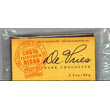Citric Tart & Tang – Cacáo seeds contain trace amounts of citric acid, augmented by the dual functions of…
 a) cacáo pulp penetrating the beans during fermentation, decreasing their pH levels from around 6.5 at harvest down to as low as 4.0, thus making them more acidic – mainly acetic acid generated in the 2nd (re: aerobic) stage in the ferment by bacteria belonging to the acetobacteraceae group; fermentation lasts 40 to 80 hours, depending on varietal, with a rule of thumb that longer ferments yield more acidic beans; b) acids conversely evaporate thru gradual drying techniques, either in the sun or mechanically forced-dried (excessive acidity is usually caused by rapid fire-drying at high temperatures which hardens the husk or shell surrounding the bean, making an impermeable shield, locking acetic acids inside, preventing their escape). Finally, one of the last steps in the manufacturing sequence – conching (stirring chocolate) – can control acidity thru a dual action of shear & heat adjustments which drive off acetic acid. A shorter conch, for example, would tend to leave more acidity intact.
a) cacáo pulp penetrating the beans during fermentation, decreasing their pH levels from around 6.5 at harvest down to as low as 4.0, thus making them more acidic – mainly acetic acid generated in the 2nd (re: aerobic) stage in the ferment by bacteria belonging to the acetobacteraceae group; fermentation lasts 40 to 80 hours, depending on varietal, with a rule of thumb that longer ferments yield more acidic beans; b) acids conversely evaporate thru gradual drying techniques, either in the sun or mechanically forced-dried (excessive acidity is usually caused by rapid fire-drying at high temperatures which hardens the husk or shell surrounding the bean, making an impermeable shield, locking acetic acids inside, preventing their escape). Finally, one of the last steps in the manufacturing sequence – conching (stirring chocolate) – can control acidity thru a dual action of shear & heat adjustments which drive off acetic acid. A shorter conch, for example, would tend to leave more acidity intact.







